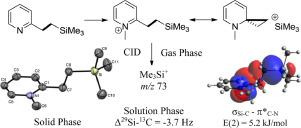Journal of Organometallic Chemistry ( IF 2.1 ) Pub Date : 2021-08-24 , DOI: 10.1016/j.jorganchem.2021.122050 Asimo Karnezis 1 , Samuel C. Brydon 1 , Andrew Molino 2 , David J.D. Wilson 2 , Richard A.J. O'Hair 2 , Jonathan M. White 1

|
The γ-effect of the group 14 metals is a stabilizing interaction involving the back-lobe of the σC-M (M = Si, Ge, Sn, Pb) interacting with the developing carbocation γ to the tetrel. This percaudal interaction has been observed in solvolysis experiments with significant rate enhancements over unsubstituted systems, and subsequent isolation of three-membered ring products. In this study, the γ-effect is experimentally investigated in the solid phase with X-ray crystallography, the solution phase with Si-C coupling constants, and the gas phase via collision-induced dissociation (CID). Moving from 2- and 4-silylethyl substituted pyridines to the more electron demanding substituted pyridinium ion systems results in systematic shifts in key structural parameters including the 29Si-13C NMR coupling constants consistent with the cyclopropane-like resonance form attributable to the γ-effect. However, these shifts are much less in magnitude than those previously reported for the well documented β-effect. The gas phase CID results also reflect this with the fragmentation pathways for the silylethyl substituted systems not being dominated by the percaudal interaction, compared to previous studies where all major fragments were attributable to the β-effect. Density functional theory (DFT) calculated hyperhomodesmotic equations in combination with natural bond orbital (NBO) theory also supported the experimental trends with the γ-effect providing stabilization in the pyridinium ion systems studied, but to a much smaller extent to the β-effect.
中文翻译:

2-和4-[2-甲硅烷基乙基)]吡啶和吡啶鎓离子中γ-效应表现的实验和理论研究
第 14 族金属的 γ 效应是一种稳定相互作用,涉及 σ C-M(M = Si、Ge、Sn、Pb)的后瓣与发展中的碳正离子 γ 相互作用。在溶剂分解实验中观察到这种 percaudal 相互作用,与未取代的系统相比,速率显着提高,随后分离了三元环产物。在这项研究中,γ 效应在固相中用 X 射线晶体学、溶液相中的 Si-C 耦合常数和气相中通过碰撞诱导解离 (CID) 进行了实验研究。从 2- 和 4- 甲硅烷基乙基取代的吡啶转移到更需要电子的取代吡啶鎓离子系统导致包括29 Si-13 C NMR 耦合常数与归因于 γ 效应的环丙烷类共振形式一致。然而,这些变化的幅度远小于先前报道的有据可查的 β 效应。气相 CID 结果也反映了这一点,与之前所有主要碎片都归因于 β 效应的研究相比,甲硅烷基乙基取代系统的碎片途径不受尾端相互作用的支配。密度泛函理论 (DFT) 计算出的超同质方程与自然键轨道 (NBO) 理论相结合,也支持了实验趋势,γ 效应在所研究的吡啶离子系统中提供了稳定性,但对 β 效应的影响要小得多。











































 京公网安备 11010802027423号
京公网安备 11010802027423号